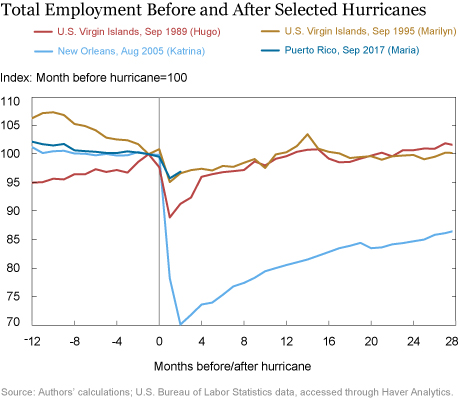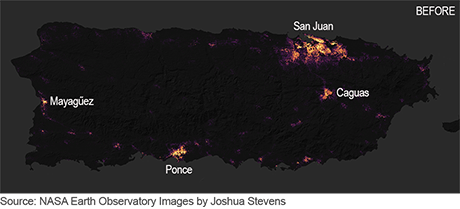Just two weeks after most of Puerto Rico dodged the proverbial bullet, missing the brunt of Hurricane Irma, the island was devastated by Maria—one of the ten strongest Atlantic hurricanes on record. Making landfall on September 20, 2017, the storm caused not only massive physical destruction and tragic loss of life but also widespread and persistent power outages, shortages of potable (and even nonpotable) running water, and disruptions to telecommunications and travel, among other issues. With the storm boosting costs and disrupting activity, the short-term economic impact is clearly significant. But an even greater concern is that the adverse short-term effects of the storm, overlaid on an already shrinking economy, may evolve into long-term adverse effects. In this post, we focus on the magnitude, duration, breadth and nature of the economic disruptions, as measured mostly by employment.
Based on what we’ve learned from past natural disasters in other regions, we consider how Puerto Rico’s economy might be affected in the longer run. Still, it is important to note a few unique features of this disaster that complicate comparisons with other natural disasters. First, while electricity has gradually been restored to parts of the island, the power outage has lasted much longer than has been the case after comparable disasters. Second, Puerto Rico’s dire fiscal situation, heading into the storm, is somewhat unprecedented. Third, while the economies of most islands in the hurricane-prone Caribbean are driven by tourism, Puerto Rico’s is much more diversified. These and other issues make it harder to predict Puerto Rico’s post-hurricane prospects based on history.
Damage to Infrastructure and Capital
When we talk about the economic “cost” of a disaster, we are usually thinking of two components: physical damage and lost (forgone) economic output. Estimates of the physical (capital) damage wrought by Maria—to infrastructure, businesses, homes, and personal property—vary widely at this point. In late September, Moody’s estimated the capital loss at up to $55 billion, part of an overall cost estimate ranging from $45-95 billion. In contrast, the Puerto Rican consulting firm Estudios Técnicos has estimated the capital loss in the range of $16-20 billion. In short, while capital losses are in principle clearly defined and measurable, it often takes a good deal of time to tally them up with any degree of accuracy—especially after a disaster of this magnitude. We will not address these costs further in this blog post.
Lost Economic Output
The other major loss component, lost economic output (or income), is harder to define but can be roughly estimated based on incoming economic data. Moreover, history shows that short-term trends in a local economy after a major disaster can give us a clue about the long-term economic impact. Usually, preliminary estimates of the economic fallout from such disasters have turned out to be overly pessimistic—as noted in this 1994 study. A more recent example of initial economic cost estimates turning out to be too high occurred after Hurricane Sandy. Such disasters—including numerous hurricanes that have devastated Caribbean islands—have rarely derailed a regional or local economy for more than a year.
However, one exception to this was New Orleans following Hurricane Katrina. That disaster does appear to have had a long-lasting adverse effect on the local economy—employment in the New Orleans metro area fell by roughly 30 percent after Katrina and even now, more than a decade later, has only made up three-quarters of that drop, with employment still more than 7 percent below its pre-Katrina level.
Now that Puerto Rico is struggling to rebound from Maria, many are concerned about its long-term prospects. This concern is amplified by the fact that the Commonwealth had already been struggling with a weak economy and a fiscal crisis before the storm. While the U.S. Virgin Islands and many other Caribbean islands have seen comparable devastation from hurricanes, Puerto Rico has not—at least not in modern times. Hurricane Georges in 1998 caused significant damage in Puerto Rico but barely had a measurable effect on the overall economy.
So how can we estimate a storm’s economic cost? Economic output, as well as income, typically declines more sharply than employment in the immediate wake of major disasters and disruptions—for example, a manufacturer, wholesaler, or restaurateur that has to shut down for a week or two is unlikely to lay off most or any of their workers. But what happens to businesses that have to stay closed longer, because of severe damage or a persistent lack of electricity? Only time will tell. Nevertheless, employment is probably the most timely and accurate indicator of sustained drops in activity. Thus, analyzing incoming employment data and comparing them with historical benchmarks (employment data after past hurricanes) can give us a sense of how bad the economic fallout has been, and may even provide a clue as to how quickly Puerto Rico’s economy is likely to recover. Will it look like post-Katrina New Orleans or will it follow the more usual pattern?
Employment Trends in October and November
In October, Puerto Rico’s payroll employment is estimated to have fallen by about 4 percent (seasonally adjusted)—a huge drop, but not unusually large after a hurricane. Encouragingly, employment rebounded about 1 percent in November. To put this in perspective, we compare it with three somewhat similar precedents: the U.S. Virgin Islands after Hurricane Hugo (1989) and again after Hurricane Marilyn (1995), and metro New Orleans after Hurricane Katrina (2005). As shown in the chart below, Puerto Rico’s recent job loss appears comparable in magnitude to the Virgin Islands’ in 1995, but somewhat less severe than the Virgin Islands’ in 1989 and significantly less than New Orleans’ in 2006 and beyond.

A look at the profile of job losses by industry also reveals close similarities with these earlier hurricanes. As is typically the case, the sharpest job losses have occurred at restaurants, bars, hotels, and retailers. In normal economic rebounds from disasters, employment in those same industries tends to recover gradually over the course of the next nine to twelve months, while other industries bounce back more quickly. There were also steep job losses in wholesale trade and health and education services, whereas sectors like professional and business services, manufacturing, construction, and finance did not see significant declines. If history is any guide, construction employment is likely to rise sharply in the months ahead, partially offsetting lingering weakness in some sectors. While the available employment data exclude Puerto Rico’s farm sector, it should be noted that extensive crop damage has reportedly taken a huge toll on the island’s farmers and $1 billion agricultural industry.
One might understandably be skeptical of the monthly employment numbers cited above, figures based on a survey of businesses. It is conceivable that many of the hardest-hit businesses were unable to respond to the October and even November surveys, in which case the employment data may understate the true severity of the job losses. However, a look at weekly initial unemployment insurance claims—a complete count, not a survey—seems to confirm the rough magnitude of the initial job loss. Specifically, the total number of incremental claims (over and beyond pre-Maria levels) filed since late September add up to about 39,000 or just under 4.5 percent of employment, which is quite comparable to the net job loss reported from August to October.
Another source of timely information comes from the the Institute of Statistics’ monthly survey of purchasing managers in Puerto Rico’s manufacturing sector. That survey showed a steep drop-off in production activity in September and October but a fairly sturdy rebound in November.
Which Parts of Puerto Rico Were Hit Hardest?
Partly owing to the trajectory of the storm, the northern and eastern parts of the island tended to be hit somewhat harder (headwinds) than the southern and western parts (tailwinds). The local employment data within Puerto Rico do not show dramatic local differences but do indicate somewhat steeper losses in the San Juan area (northeast) than in the Mayaguez (west) or Ponce (south) areas.
Perhaps the most problematic lingering issue has been widespread power outages across the island. Given that lights are sometimes used as a proxy measure of economic activity, data on the intensity of nighttime light emissions (recorded daily by satellites) provide a particularly useful tool for monitoring the recovery across the island. The maps below show night lights across Puerto Rico in August (pre-Maria), October, and November. The relative dimness throughout the island in October underscores the severity and breadth of the power outage. The moderate improvement in November—more notable in the south and west than in the north and east—illustrates that the power situation has improved somewhat, though it remains fairly dire over much of the island.
Puerto Rico is divided into 78 municipios of varying sizes, with populations ranging from 400,000 (San Juan) to just under 2,000 (Culebra). Among the twenty brightest (and therefore the most densely populated) municipios, the change in brightness between August and November ranged from a 10 percent drop in Hormigueros, in the west, to a 74 percent decline in Humacao, on the southeastern coast. The reduction in night lights varied widely across the island; the areas with the quickest recoveries were found in the south and west of Puerto Rico, including Ponce and Mayaguez, whereas the eastern coast saw the greatest fall in lighting. Thus, Puerto Rico’s local variation in night lights recovery closely parallels both the losses in employment found across the island and the trajectory of the storm—as Maria passed from east to west, the north received the stronger headwinds while the south and west experienced less severe tailwinds. A notable exception can be found in and around San Juan—despite being hit hard by the storm, these municipios fell near the middle in terms of light loss; as the capital and largest city in Puerto Rico, electricity may have been restored more quickly there than in more rural areas.

The Outlook
While the initial economic fallout from a disaster is not necessarily a predictor of the long-term effect, historically the two do seem to have been correlated. That is, the steeper the initial loss of jobs (and population), the longer it tends to take a local economy to recover. Puerto Rico’s population had already been trending down at about 2 percent per year before Maria. Given Maria’s huge adverse effect on the general quality of life—power outages, shortage of potable water, health issues, transportation and communication disruptions—there has been much concern that the rate of population loss could accelerate sharply and create a vicious spiral: people emigrating, businesses closing, tax base shrinking, cuts in services and tax hikes leading to still more out-migration, and so on. In spite of the storm’s devastating initial impact, that worst-case scenario for the island’s economy appears to have been averted—at least thus far. We will continue to monitor the situation.
Disclaimer
The views expressed in this post are those of the authors and do not necessarily reflect the position of the Federal Reserve Bank of New York or the Federal Reserve System. Any errors or omissions are the responsibility of the authors.

Jason Bram is a research officer in the Federal Reserve Bank of New York’s Research and Statistics Group.
 Lauren Thomas is a senior research analyst in the Bank’s Research and Statistics Group.
Lauren Thomas is a senior research analyst in the Bank’s Research and Statistics Group.
How to cite this blog post:
Jason Bram and Lauren Thomas, “Beginning to Gauge Maria’s Effect on Puerto Rico’s Economy,” Federal Reserve Bank of New York Liberty Street Economics (blog), January 12, 2018, http://libertystreeteconomics.newyorkfed.org/2018/01/beginning-to-gauge-marias-effect-on-puerto-ricos-economy.html.











 RSS Feed
RSS Feed Follow Liberty Street Economics
Follow Liberty Street Economics